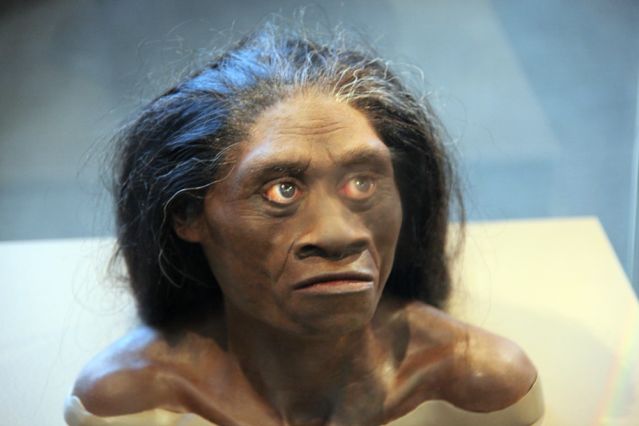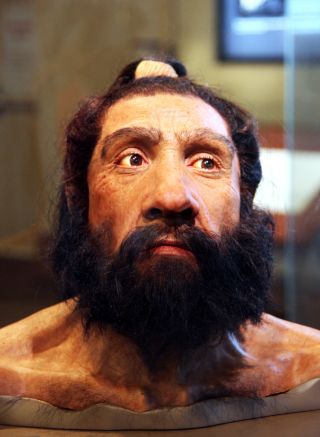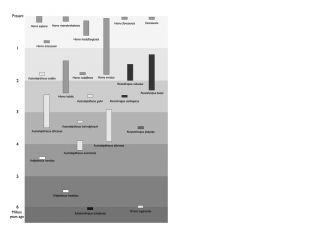Genetics
How Did We Become So Unique?
Humans used to share this planet with other smart, upright-walking hominins.
Posted January 20, 2014

homo floresiensis
Great apes have not always been humans’ closest living relatives. Only two thousand generations ago we still shared this planet with several upright-walking, fire-controlling, tool-manufacturing cousins, including big Neanderthals (Homo neanderthalensis) and small “Hobbits” (Homo floresiensis). With its various bipeds, it was a world reminiscent of Tolkien’s Middle Earth. Our ancestors 40,000 years ago would have had much less reason than we have today to believe they were far removed from the rest of the Earth’s creatures. We were but one of a group of similar species.
A picture persists of our ancestors evolving in a straightforward, single, and direct trajectory, up a stairway to Homo sapiens. This was not the case. For millions of years, many species of humans, technically called “hominins,” wandered the planet and sometimes shared the same valleys. For example, between 1.6 and 1.8 million years ago, there were three genera of distinct hominins (Australopithecus, Homo, and Paranthropus) each comprising several species, ranging from the slender Homo habilis, makers of stone tools, to the stockier Paranthropus robustus, with their massive, powerful jaws. Though there are debates about how many species need to be distinguished (a 2013 fossil find from Georgia suggests that species could be quite diverse), it is clear that for much of the past our ancestors shared the planet with diverse other hominins. There were also other types of apes such as the spectacular Gigantopithecus—an ape three meters tall that may have resembled Chewbacca from Star Wars.

homo neanderthalensis
Our direct line of descent is only one branch on a flourishing, bushy tree of closely related species. Some of these species were immensely successful. Paranthropus boisei, a heavily built hominin with a wide face, and the tall and large-brained Homo erectus each graced the planet for well over a million years. Modern humans have been here a mere fifth of that time. While there are clear signs of gradual improvements, for instance, in terms of increases in cranial capacity and tool sophistication, evidence also points to considerable diversification. Several new species have been described in the last decade. If the frequency of recent discoveries is anything to go by, paleoanthropologists might find many more fossils of hitherto unknown relations, and we can expect an ever more complex family tree.
Yet today Homo sapiens is the only member of the human family left on this planet, and it so happens that a few species of great apes are our closest remaining relatives. In an important sense, then, the answer to the question of why we appear so different from other animals is that all closely related species have become extinct. We are the last humans.
Why is ours the only surviving lineage in this multitude of human forms? Why did the others die out? The various extinctions, like those of other species, were probably complex processes involving a multitude of factors, including radical environmental changes such as ice ages and volcanic eruptions. But for the disappearance of our close relatives we should consider another potential culprit: our ancestors.

Currently widely recognized hominins of the last six million years (Some would sub-divide fossils further - others would merge)
Humans have been responsible for the demise of many species in recent times and, although we have no direct evidence, may well have had a hand in the extinctions of Neanderthals and other close relatives. Once our ancestors had managed to control much of the classic ecological challenges of survival, including predation by big cats and bears, members of the human family probably became their own primary adverse force of nature. We are more likely to be threatened, coerced, or killed by another human than by any animal. Aggression and conflict may have greatly affected hominin evolution.
A technologically advanced population can have devastating effects on other groups. People may be exterminated not only through killing but also indirectly through competition, habitat destruction, or even the introduction of novel germs. In his book Guns, Germs, and Steel, the evolutionary biologist and geographer Jared Diamond vividly recounts the extraordinary case of a mere 168 conquistadors ransacking the Inca Empire in 1532. Most Incas were, in fact, killed by smallpox. The invaders brought the deadly disease, which swept ahead of their advance. The wholesale loss of life was an advantageous side effect for the Spanish—a result of hundreds of years of suffering from the disease in Europe. But some conquerors may have been aware of such causal chains and actively facilitated the process, guaranteeing widespread deaths as a result. British colonists, for example, have been accused of intentionally giving blankets infested with smallpox to native North Americans. It is unclear how common such callous acts were. What is evident is that humans are capable of them.
Yet we are also capable of extraordinary cooperation, empathy, and kindness. We can, and I would hasten to say should, make ethical choices that avoid exterminations of other people or species. As Steven Pinker recently documented in The Better Angels of Our Nature, violence has gradually declined over the course of history. In other words, war, blood feuds, murder, rape, slavery, and torture were more commonplace in our past. Evidence of violent conflict goes back to prehistoric hunter-gatherers, but it is unknown when this dark side first emerged. Common chimpanzees are the only other primate species known to cooperate to directly kill members of their own species. So cooperative aggression may have ancient roots indeed.
No doubt our forebears at times would have also attempted to interbreed with close relatives, and they may have assimilated those with whom they could successfully reproduce. There is some anatomical evidence that humans and Neanderthals interbred, and in 2010 the first genetic evidence demonstrated that Europeans and Asians, in contrast to Africans, still carry some Neanderthal inheritance estimated at between 1 and 4 percent. In other words, I am part Neanderthal.
The logic is simple. When Neanderthal DNA is compared to different African groups of humans, they are equally different from each group. If, however, the DNA is compared to a European and an African, it more often matches the European than the African DNA. The same is true for tests with Chinese DNA. This suggests that when modern humans migrated out of Africa, they mixed with Neanderthals, presumably in the Middle East, where fossil evidence demonstrates prolonged cohabitation, and then carried the Neanderthal component of their genome to the world outside of Africa.
In December 2010, a thirty thousand-year-old finger and tooth of another previously unknown human family member were described. Genetic analysis revealed that these so-called Denisovans (the fossils were found in the Denisova cave in the Altai mountains of Siberia) were distinct from modern humans and from Neanderthals. They contributed about 5 percent to the genome of modern-day Melanesians.
Although sometimes represented as alternatives, making love and making war are not mutually exclusive possibilities. There is love as well as rape in times of war, and romance can result in conflicts. One way or another, it seems likely our forebears played important roles in the disappearance of at least some of our closest relatives. The reason the current gap between animal and human minds seems so large and so baffling, then, may be because we have destroyed the missing links. By displacing and absorbing our hominin cousins, we might have burned the bridges across the gap, only to find ourselves on the other side of the divide, wondering how we got here. In this sense, our exceedingly mysterious and unique status on Earth may be largely our own, rather than God’s, creation.
What’s more, we appear to be continuing this process. We may not only increase the divide through technological advances (and possibly becoming smarter), but by wiping out our nearest animal relations. All the great ape species are endangered, and their numbers are declining for essentially one reason: human activity. Whether through habitat destruction, bush-meat consumption, or the pet trade, we are causing the demise of our closest animal relatives, not entirely unlike what we may well have done to our upright-walking hominin relatives in the past. There are, of course, humans who are desperately trying to stop the extinction of apes, and I encourage you to join them, but the current projections are bleak. In a couple of generations, our descendants might wonder at just how different they are from their closest remaining animal relatives: the monkeys.
Apes may join Neanderthals and Paranthropus as half-forgotten creatures of the past. So our descendants may be even more baffled by their own apparent uniqueness (and possibly be distracted by questions about the importance of the fact that monkeys typically have tails whereas humans do not). Let’s make sure they are more enlightened about the nature and origin of the gap. We better protect our tailless ape relatives carefully—for their own sake, as well as for the sake of our children.
Copyright Thomas Suddendorf
Adapted from the book THE GAP: The Science Of What Separates Us From Other Animals




